Osmaronia cerasiformis - Oso berry [May 6, 2016]
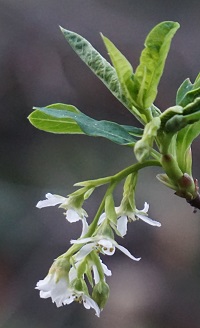 Oemleria cerasiformis (Oso berry)
Oemleria cerasiformis (Oso berry)
Family: Rosaceae
Genus: Oemleria
Common names: Oso berry, Indian plum
This underutilized plant can be cultivated as either a shrub or small tree. It grows up to 12 feet tall and 8 feet wide when mature.
It is deciduous but forms bright green leaves in early spring. It develops flowers at the same time, with cascades of small white flowers appearing as soon as February. Bloom can continue for a couple months and is followed by fruit in late spring and early summer.
One of its common names, Indian plum, comes from its fruit, which resemble small plums when ripe. Its fruit is popular with birds making it a great addition to a habitat garden.
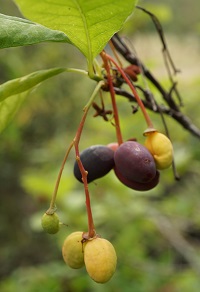
This plant is dioecius, which means that male and female flowers bloom on different plants. You must have at least one of each before the female plants will set fruit. Both male and female plants produce flowers, although the male flowers tend to be a bit showier. Some people think the scent of the male flowers is unpleasant, while the female flowers are said to smell like watermelon.
Oso berry prefers loamy soil, but will tolerate clay. In the wild, it is usually found in moist areas, and it will grow more quickly when provided with water. It is able to handle dry conditions once established. It prefers light shade, but can tolerate full sun.
The Life of a CNPS SCV Nursery Plant
When you buy a plant at our nursery, you’re getting the result of a year or more of careful nurturing by our volunteers.
Our plants are grown from both seeds and cuttings, which we obtain from our stock area, commercial growers and CNPS members. We don’t focus on a specific area of the California Floristic Province, so we grow plants for a wide variety of environments from many regions of California – in addition to a wide variety of local natives, we also raise plants from the mountains, deserts and wetlands.
Read more ...
Phytophthora in our Nursery?
- Details
-
Last Updated: Tuesday, 11 June 2019 01:48
By Melanie Cross, Chapter Nursery Manager
8/19/2015
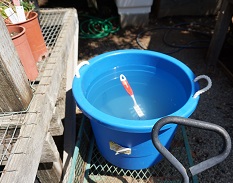 An issue that has surfaced in native plant nursery and revegetation circles this year is the appearance of deadly exotic pathogens: Phytophthora species, and lots of them. You may know of this algae relative because sudden oak death is caused by an airborne species, P. ramorum. The new pathogens that are showing up are water-borne. Susceptible plants at revegetation sites and other landscapes have been devastated by these “plant destroyers.” Unfortunately, nurseries offer the right conditions to cultivate and disseminate them. This is just what we do not want to do.
An issue that has surfaced in native plant nursery and revegetation circles this year is the appearance of deadly exotic pathogens: Phytophthora species, and lots of them. You may know of this algae relative because sudden oak death is caused by an airborne species, P. ramorum. The new pathogens that are showing up are water-borne. Susceptible plants at revegetation sites and other landscapes have been devastated by these “plant destroyers.” Unfortunately, nurseries offer the right conditions to cultivate and disseminate them. This is just what we do not want to do.
Read more ...
Pollinators and Blooming Beauties [9/16/2015]
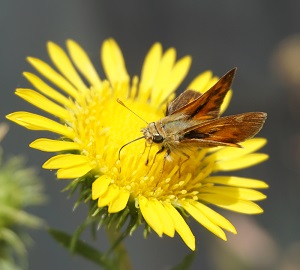
What's Blooming in the Nursery
Most of the time, these articles will be about specific plants that we think you would enjoy adding to your garden. But sometimes, we can't resist sharing the wonders that we see as we work in the nursery. This week the Grindelia camporum (Great Valley gumweed) was a pollinator magnet. Skippers, bees and flies (masquerading as bees) were busily feasting.
Of course, the parade of flowers didn't end there. A few of the others on display included:
- Achillea millefolium (common yarrow) - the Island Pink variety was eye-poppingly bright
- Corethrogyne filaginifolia (common sandaster)
- Dendromecon harfordii (bush poppy)
- Diplacus X (hybrid monkeyflower)
- Epilobium canum (California fuschia)- in addition to the usual reds, 'Summer Snow' brings white into the mix
- Ericameria nauseosa (rubber rabbitbrush)
- Eriogonum (buckwheat) - a huge selection of these wonderful summer and fall bloomers continue to put on a show.
- Monardella macrantha (hummingbird monardella)
- Monardella villosa (coyote mint)
Read more ...
Useful Vines for the Garden [August 8, 2015]
- Details
-
Published: Saturday, 08 August 2015 01:20
Two of the great vines available at the nursery are Vitis californica (California wild grape) and Clematis lasiantha (chaparral clematis). They are both useful habitat plants and can be grown as a ground cover or trained over a trellis or fence. They are tolerant of a wide variety of soils -- from clay to sandy soils.
Clematis lasianta (Chaparral clematis)
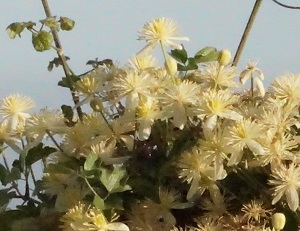 Clematis lasianta, which is also known as chaparral or pipestem clematis, is a lovely vine that is covered with gorgeous white flowers in the spring. The flowers are followed by fluffy white seed heads that make the plants look like they're covered in cottonballs. It can grow fifteen to twenty feet tall. This plant loves full sun although it prefers some shade for its roots. It does not need supplemental water after it is established. It is deciduous and may die back in cold winters, but will quickly grow back in the spring. You can see these vines in flower on many local trails in the spring.
Clematis lasianta, which is also known as chaparral or pipestem clematis, is a lovely vine that is covered with gorgeous white flowers in the spring. The flowers are followed by fluffy white seed heads that make the plants look like they're covered in cottonballs. It can grow fifteen to twenty feet tall. This plant loves full sun although it prefers some shade for its roots. It does not need supplemental water after it is established. It is deciduous and may die back in cold winters, but will quickly grow back in the spring. You can see these vines in flower on many local trails in the spring.
More at Las Pilitas and Calflora.
Vitis californica (California wild grape)
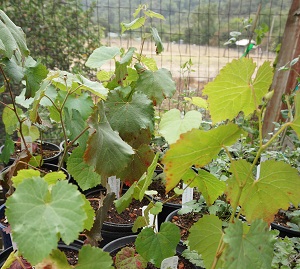
Vitis californica has beautiful, large green leaves that provide an excellent cover in the summer. In the wild, it is typically found along streams and other moist areas, but is adaptable to dry conditions after it is established. It is a deciduous vine that can grow over thirty feet tall. Since it sheds its leaves in the winter, it's great over an arbor or trellis for summer shade and winter sun. It produces bunches of small purple grapes in the fall. The grapes are edible, but tend to be tart.
Maintenance is easy. Agi Kehoe, an active member of the Gardening With Natives subgroup shares these simple pruning instructions:
Winter pruning: thin out the vine by removing all but the major canes that form the structure. Once finished, there should be one mature cane per wire line on a fence, and maybe 3 canes on a 2' wide arbor. Cut the canes back to 2-3 buds, each cut should be 1/4" above the leaf node. This is also the time to secure the large canes to the trellis with ties.
Active growing season pruning: maintain the fast growth. If trained on a fence, prune to keep it close to the fence; if trained on an arbor, leave some fresh green canes hanging down from the arbor to create a softer look.
More at Las Pilitas Nursery and Calflora.
 Oemleria cerasiformis (Oso berry)
Oemleria cerasiformis (Oso berry)


 An issue that has surfaced in native plant nursery and revegetation circles this year is the appearance of deadly exotic pathogens: Phytophthora species, and lots of them. You may know of this algae relative because sudden oak death is caused by an airborne species, P. ramorum. The new pathogens that are showing up are water-borne. Susceptible plants at revegetation sites and other landscapes have been devastated by these “plant destroyers.” Unfortunately, nurseries offer the right conditions to cultivate and disseminate them. This is just what we do not want to do.
An issue that has surfaced in native plant nursery and revegetation circles this year is the appearance of deadly exotic pathogens: Phytophthora species, and lots of them. You may know of this algae relative because sudden oak death is caused by an airborne species, P. ramorum. The new pathogens that are showing up are water-borne. Susceptible plants at revegetation sites and other landscapes have been devastated by these “plant destroyers.” Unfortunately, nurseries offer the right conditions to cultivate and disseminate them. This is just what we do not want to do.
 Clematis lasianta, which is also known as chaparral or pipestem clematis, is a lovely vine that is covered with gorgeous white flowers in the spring. The flowers are followed by fluffy white seed heads that make the plants look like they're covered in cottonballs. It can grow fifteen to twenty feet tall. This plant loves full sun although it prefers some shade for its roots. It does not need supplemental water after it is established. It is deciduous and may die back in cold winters, but will quickly grow back in the spring. You can see these vines in flower on many local trails in the spring.
Clematis lasianta, which is also known as chaparral or pipestem clematis, is a lovely vine that is covered with gorgeous white flowers in the spring. The flowers are followed by fluffy white seed heads that make the plants look like they're covered in cottonballs. It can grow fifteen to twenty feet tall. This plant loves full sun although it prefers some shade for its roots. It does not need supplemental water after it is established. It is deciduous and may die back in cold winters, but will quickly grow back in the spring. You can see these vines in flower on many local trails in the spring.